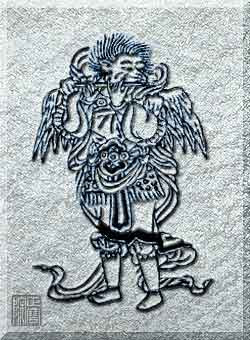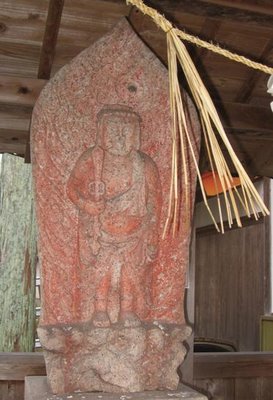[ . BACK to Daruma Museum TOP . ]
七天狗 - Seven Tengu,
see below
:::::::::::::::::::::::::::::::::::::::::::::::::::::::::::::::::::::::::::::::::::::::::::::::::::::
Hitokotonushi 一言主
Local people also call this deity in the temple: Ichigonji san
いちごんじさん, 一言寺.
The Shrine for Hitokotonushi 一言主神社
Katsuraki, Katsuragi, Kazuraki, Kazuragi, Hitokotonoshi
Dedicated to Hitokotonushi no kami, or literally the
God of One Word, who is referred to in the Nihon Shoki Chronicles. The god only grants requests made in one word or one request for each person praying to him. Others say in his oracles he only utters only one word of good or bad.
In fall, the sight of the tall ginkgo tree leaves turning yellow is breathtaking. In the precinct are
Kumozuka, or spider mound, whose origin is in the Nihon Shoki, and a monument inscribed with a haiku poem by the travelling poet Basho Matsuo.
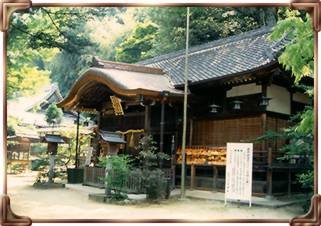 © Text and Photo: Katsuragi Kodoo 葛城古道
© Text and Photo: Katsuragi Kodoo 葛城古道
Hitokotonushi is most probably identical with
Kotoshironushi 事代主(ことしろぬし、言代主神)
Yae Kotoshironushi 八重言代主神、八重事代主神(ヤエコトシロヌシ)
a deity known for its oracle powers, spreading the word of the gods among the people.
Hitokotonushi was the "God of the Rice Paddies" from Katsuragi area.
In olden times, there were five famous shrines in the Katsuragi area.
The word "KOTO 言" in the name of this deity means "Oracle".
Ta no Kami, God of the Rice Fields and Haiku 田の神さま
:::::::::::::::::::::::::::::::::::::::::::::::::::::::::::::::::::::::::::::::::::::::::::::::::::
 source : facebook
source : facebook
:::::::::::::::::::::::::::::::::::::::::::::::::::::::::::::::::::::::::::::::::::::::::::::::::::
Katsuragi no hitokotonushi no ōkami (Kojiki)
A god (kami) appearing on Mount Katsuragi, near the border of Yamato and Kawachi Provinces, and who could utter oracles of good or evil with the decisive speaking of a "single word" (hito-koto). The central deity (saijin) of the Hitokotonushi Shrine in Katsuragi, Katsurakami District, Yamato Province (present-day Nara Prefecture).
According to Kojiki, when
Emperor Yuryaku climbed Mount Katsuragi with his many courtiers, they encountered another troupe having identical appearance. Enraged, the emperor readied his arrow and asked for the names of those in the opposing group. The leader of the group responded,
"I am Hitokotonushi no kami of Katsuragi,
who proclaims evil in a single word,
good in a single word."
Upon hearing this, the emperor and his courtiers removed their garments and offered them to the kami. Similar stories are found in Nihongi and Shoku Nihongi; the version in Nihongi reflects ancient beliefs in hermetic mountain wizards.
© Matsunaga Naomichi, Kokugakuin University.
http://eos.kokugakuin.ac.jp/modules/xwords/entry.php?entryID=63
:::::::::::::::::::::::::::::::::::::::::::::::::::::::::::::::::::::::::::::::::::::::::::::::::::
(かつらぎひとことぬしじんじゃ)Shrine Hitokotonushi
The great Gingko Tree
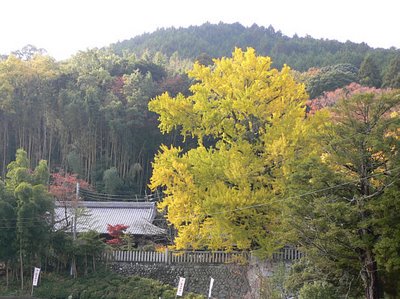 © PHOTO Teranishi 寺西
© PHOTO Teranishi 寺西
:::::::::::::::::::::::::::::::::::::::::::::::::::::::::::::::::::::::::::::::::::::::::::::::::::
En no Gyooja (E no ubasoku) , the famous mountain ascetic around 700.
He is famous for roaming the area of Mt. Katsuragi.
Here is one old legend:
E no ubasoku was of the Kamo-no-enokimi family, presently the Takakamo-no-asomi family. He came from the village of Chihara, Upper Kazuraki district, Yamato province. By nature he was endowed with wisdom; he excelled in learning and attained ultimate knowledge. He lived with reverence and faith in the Three Treasures.
His greatest desire was to fly on a five-colored cloud beyond the sky and play in the garden of eternity with the guests of the heavely palace, lying in the flowering garden and sucking the vital force out of the haze to nourish his nature.
Accordingly, in his late forties he went to live in a cave, wore clothing made of vines, drank the dewdrops on pine needles, bathed in pure spring water to rinse away the filth of the world of desire, and learned the formula of the Peacock to attain extraordinary power. Thus he could employ spirits and gods at his command at his command.
Once he summoned them all and ordered them, "Make a bridge between Kane-no-take and Kazuraki-no-take."
Hitokotonushi no Okami, who was very ugly, only ventured out at night to help. But the gods were not happy about the bridge building, and in the reign of the emporer residing at Fujiwara Palace,
Hitokotonushi no Okami of Kazuraki-no-take was possessed and slandered him, saying, "E no ubasoku plans to usurp the throne." The emporer dispatched messengers to capture him, but they found it hard to take him due to his mysterious power, so they captured his mother instead. In order that his mother might be freed, he gave himself up.
He was exiled to the island of Izu. One time his body went floating on the sea as if he were walking on land. Again, his body perched on a mountain ten thousand feet high and looked like a huge phoenix in flight. In the daytime he stayed on the island in accord with the emporer's command, but at night he went to
Fuji-no-take [Mt. Fuji] in Suruga to practice austerities.
As he prayed for pardon from his severe punishment and for permission to return to the capital, he lay down on the blade of an assassin's sword and ascended Mt. Fuji. Three years passed in ascetic practice after he was exiled to the island. At the turn of the eighth year of the ox, the first year of the Taiho era, he was pardoned and approached the capital, finally becoming a saint and flying to heaven.
Dharma Master Dosho of our country received an imperial order to go to Great T'ang China in order to search out Buddhist teachings. On the request of five hundred tigers he went to Silla to lecture in the mountains on the Hoke-kyo. At that time there was a man among the tiger who raised a question in Japanese. The monk asked, "Who are you?" and the man answered,
"E no ubasoku." The monk thought that the man was a Japanese sage and came down from his high seat to inquire about him, but he was gone.
Hitokotonushi no Okami was bound with a spell by E no gyoja, and he has not escaped even to this day. E no ubasoku did so many miraculous deeds that we cannot enumerate them all. Indeed we learn that Buddhist miraculous arts are comprehensive. Those who have faith will attain them without fail.
© nichirens coffeehouse.net
Zenkiboo Zenkibō 前鬼坊 Zenkibo
大峰山前鬼坊 Ominesan Zenki-Bo, to become a Tengu
and his wife Goki 後鬼.
.......................................................................
吉野
Yoshino
役行者
En no Gyôja
tried to convince the local Shinto deity, Hitokotonushi,
to help him build a 石橋
stone bridge extending from Mt. Katsuragi to Mt. Yoshino.
Hitokotonushi only worked during the night and hid his face during the daytime. Thus En no Gyoja became angry at the slow pace of the god's work, and threw him into a valley. The angry god then petitioned the emperor to send armies after En no Gyôja, to arrest him, claiming that the monk sought to rebel against the throne. Gyôja escaped the armies easily, flying away on his clouds, but, after they captured his mother instead, he was forced to surrender himself.
He was exiled to Izu Ôshima, but escaped his exile, flying to Mt. Fuji. .....

大和葛城山久米の岩橋伝説 -
The Legend of the Stone Bridge at Kume, Katsuragisan
- reference source : toki.moo.jp/gaten -
Click HERE to see more photos !
. 那智滝本前鬼坊 - Zenkibo, Nachinotakimoto - Nara .
:::::::::::::::::::::::::::::::::::::::::::::::::::::::::::::::::::::::::::::::::::::::::::::::::::
Kootenboo 葛城高天坊 - Katsuragi Kotenbo
He is one of the
. 四十八天狗 48 important Tengu of Japan .

He is venerated as 天狗魔王尊
Tengu Mao Son at mount Tengudake.
He is the boss of the 畿内七天狗 seven Tengu of the Kinai districts around Kyoto.
. 護法魔王尊 Gohoo Maoo Son .
at Mount Kurama 鞍馬山.
天狗岳 Mount Tengudake, - 558 m - also called
燈明ヶ岳 Tomyogadake,. 犬鳴山 Inunakisan, 天狗魔王岳 Tengu Maodake
 source : blog.goo.ne.jp/yochanh1947...
Tengu Mao Son
source : blog.goo.ne.jp/yochanh1947...
Tengu Mao Son is the boss of the Kinai Shichi Tengu 畿内七天狗
seven Tengu of the Kinai district around Kyoto.
Mentioned in the 天狗経 Tengu Sutra:
The others are
鞍馬の僧正坊 - Sojo-Bo from Kurama
愛宕山の太郎坊 - Taro-Bo from Mount Atago
笠置山の大僧正 - Daisojo from Kasagizan
熊野大峯の菊犬坊 - Kikujo-Bo from Kumano Omine
吉野の皆杉小桜坊 - Kozakura-Bo from Yoshino Minasugi
那智滝本の前鬼坊 - Zenki-Bo from Nachi
高野山の高林坊 - Korin-Bo from Koyasan
. 転法輪寺 Tenporin-Ji .
Demukae Fudoo-son 出迎え不動明王
To pray for the safety of the climb to the shrine
Katsuragi Jinja on top of the mountain.
- 葛城高天坊に会いに行った
- reference source : youkaiblog.blog75.fc2.com...602... -
.......................................................................
根来忍者僧「七天狗」Shichitengu, Shichi Tengu
"Seven Tengu" Ninja from Negoro
いずれも総髪に僧形をした忍者で、全員が淫石を作るための術を心得る。薙刀などの普通の武術や忍者の技を使う他、それぞれ固有の超人の域に達する忍法の使い手でもある。
風天坊(ふうてんぼう)
Futen-Bo
武器の鎌をブーメランのように使う忍法「鎌がえし」や、自分の体そのものをブーメランのようにして宙を舞う「枯葉がえし」の忍法を持つ。
虚空坊(こくうぼう)
Koku-Bo
内面を鏡のようにした直径七尺近い巨大な傘を自在に使う、忍法「かくれ傘」の使い手。
羅刹坊(らせつぼう)
Rasetsu-Bo
特殊な針と糸で手術することで、完全に切断された人体をも蘇生させる、忍法「壊れ甕」を使う。
金剛坊(こんごうぼう)
Kongo-Bo
要に針を仕込んだ扇で、空中から時間差をつけて相手を襲う、忍法「天扇弓」を使う。
水呪坊(すいじゅぼう)
Suiju-Bo
女性の経血に浸した紙を使う忍法「月水面」を得意とする。
空摩坊(くうまぼう)
Kuma-Bo
破軍坊とともに忍法「火まんじ」を使う。
破軍坊(はぐんぼう)
Hagun-Bo
空摩坊とともに忍法「火まんじ」を使う。
- - - More in the WIKIPEDIA !
.......................................................................
Shichi Tengu-e 七天狗絵 and 天狗草紙 Tengu Zoshi
. . . CLICK here for Photos - 天狗草紙 !
 The Seven Tengu Scrolls:
The Seven Tengu Scrolls:
Evil and the Rhetoric of Legitimacy in Medieval Japanese Buddhism
Wakabayashi, Haruko
. The Seven Tengu Scrolls - Introduction .
Māra (or 魔 ma), the personification of evil
:::::::::::::::::::::::::::::::::::::::::::::::::::::::::::::::::::::::::::::::::::::::::::::::::::
.......... H A I K U
. Matsuo Basho 松尾芭蕉 - Archives of the WKD .
猶みたし 花に明行 神の顔
なほ見たし花に明けゆく神の顔
nao mitashi hana ni ake yuku kami no kao
all the more i wish to see
in those blossoms at dawn
the face of the god
Tr. Makoto Ueda
... ... ...
Memorial Stone of this Haiku by Basho
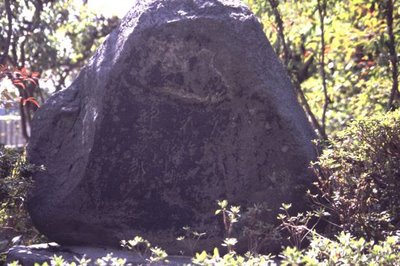 © PHOTO 牛久市森田武さん撮影
© PHOTO 牛久市森田武さん撮影
The above haiku by Basho could be rephrased like this:
"Do not be so shy, show me your face, dear God of One Word! All the cherry trees are in full bloom and everything is so beautiful here! I am sure you too will look beautiful today!"
... ... ...
Basho was quite fascinated with the atmosphere of the place and found it hard to leave without seeing the "face of this deity".
............ Other translators' versions:
Still, I would fain see
The god's face
In the dawning cherry blossoms.
--Blyth
God of this mountain,
May you be kind enough
To show me your face
Among the dawning blossoms?
--Yuasa
More than ever I want to see
in these blossoms at dawn
the god's face
--Hass
all the more I'd like to see it
with dawn coming to the blossoms:
the face of the god
--Barnhill
How I long to see
among dawn flowers,
the face of God.
-- Lucien Stryk
Written in "Oi no kobumi" 「笈(おい)の小文(こぶみ)」, at age 45.
 - quote -
Matsuo Basho haiku scroll
- quote -
Matsuo Basho haiku scroll
The text dates to around 1688 and carries the title Preamble and poem on Mount Katsuragi. It was written on one of Basho's many jaunts around Japan.
It's presented in a wooden box, which is inscribed "Scroll brushed by the venerable Basho".
The poem reads, in translation:
"Still, I would fain see / the god's face / in the dawning cherry blossoms".
In the Japanese Shinto tradition, Mount Katsuragi is home to a kami (a kind of elemental spirit) named Hitokotonushi no kami - the God of One Word.
The god's face is usually described as nightmarish, indicating just how agreeable Basho found the cherry blossoms.
This poem can also be found inscribed on a rock at the god's shrine on the mountain.
It was first published in Basho's celebrated anthology Oi no kobumi (Notes from my Backpack). ...
- source : paulfrasercollectibles.com/news -
"The face of God", for a good Christian, might evoke the image of the old man with a white beard.
Translating this "kami no kao" is really difficult.
Translating Haiku Forum
:::::::::::::::::::::::::::::::::::::::::::::::::::::::::::::::::::::::::::::::::::::::::::::::::::
一言も言わぬ吾等や寺の秋
hitokoto mo iwanu warera ya tera no aki
not even one word
can we utter here -
autumn in the temple
Gabi Greve, at Hitokotonushi Jinja, 1994
:::::::::::::::::::::::::::::::::::::::::::::::::::::::::::::::::::::::::::::::::::::::::::::::::::
葛城の山懐に寝釈迦かな
katsuragi no yamafutokoro ni neshaka kana
deep in the mountains
of Mount Katsuragi -
a statue of Buddha lying down
高濱年尾Takahama Toshio
Tr. Gabi Greve
Buddha lying down to await his end - neshaka, nehanzoo
:::::::::::::::::::::::::::::::::::::::::::::::::::::::::::::::::::::::::::::::::::::::::::::::::::
俳人松尾芭蕉は、
葛城市とは縁が深い。特に葛城市の「竹内」(現在の竹内集落)は彼が何度も訪れた場所だ。これは門人の一人、千里(ちり)が竹内出身であったことにあるようだ。
「綿弓や琵琶になぐさむ竹のおく」とは芭蕉が貞享元年(1684)に読んだ句で、葛城市には 「綿弓塚」として門人千里の屋敷跡の近くの興善庵の境内に文化六年(1809)10月、句碑が建て られている。この句も「野ざらし紀行」で見ることができる。
また、芭蕉が貞享(1688)の「笈の小文」の旅の際、吉野、高野山、和歌浦、唐招提寺、奈良、丹波市と名所見物を終えて、明日に河内へ向かうため、やぎで泊まり、その翌日に竹内の伊麻を訪問した。彼女は千里のもとで働いていた女性で、当時流行していた悪病に冒された父を助けるため、その生涯を尽くし、生涯独身で過ごしたという孝女だった。
この話に芭蕉はいたく感激し、伊麻と別れてから當麻寺に参り、「よろずのたつときも伊麻を見るまでのことにこそあなれ」と述べた。芭蕉の感激の一端が伺える文である。
千里は故郷である竹内で亡くなっている。享年72歳。その墓碑は竹内の共同墓地内にある。
http://www.city.katsuragi.nara.jp/kankou/kanko/takeuci/main.html
:::::::::::::::::::::::::::::::::::::::::::::::::::::::::::::::::::::::::::::::::::::::::::::::::::::
Hitokoto Jizo, Hitogoto Jizo 一言地蔵
 One request Jizo (hitogoto Jizo)
One request Jizo (hitogoto Jizo)
A noticeboard next to this Jizo at Rokkakudo in Kyoto says that he's inclining his neck because he's carefully considering the request made to him. However, to avoid egotism, he'll only consider one request from a petitioner so it should be a meaningful one!
- shared by John on facebook -
. . . CLICK here for more Photos !
. Jizō - Jizo Bosatsu 地蔵菩薩 - Introduction .
:::::::::::::::::::::::::::::::::::::::::::::::::::::::::::::::::::::::::::::::::::::::::::::::::::::
- quote -
Hitokoto Kannon 一言観音
One-Prayer Kannon, or Kannon of a Single Utterance, or One-Word Kannon. This deity is worshipped at various locations throughout Japan, most notably at Kōfukuji Temple 興福寺 in Nara. The temple’s web site says this: “The Hitokoto Kannon Hall was relocated to its current location in the Meiji period. It houses a hidden image of Hitokoto Kannon, or ’Avalokitesvara of a Single Utterance.’ This name for Kannon is derived from the belief that if one sincerely recites Kannon's name, Kannon is sure to respond to the devotee’s prayer.”
 Says Matsunaga Naomichi at Kokugakuin University:
Says Matsunaga Naomichi at Kokugakuin University:
“A god (kami) appearing on Mount Katsuragi, near the border of Yamato and Kawachi Provinces, and who could utter oracles of good or evil with the decisive speaking of a ’single word’ (hito-koto). The central deity (saijin) of the Hitokotonushi Shrine in Katsuragi, Katsurakami District, Yamato Province (present-day Nara Prefecture). According to the Kojiki, when Emperor
Yūryaku Tennō 雄略天皇 (5th century AD) climbed Mount Katsuragi with his many courtiers, they encountered another troupe having identical appearance. Enraged, the emperor readied his arrow and asked for the names of those in the opposing group. The leader of the group responded, ‘I am Hitokotonushi no Kami of Katsuragi, who proclaims evil in a single word, good in a single word.’ Upon hearing this, the emperor and his courtiers removed their garments and offered them to the kami. Similar stories are found in the Nihongi and Shoku Nihongi; the version in the the Nihongi reflects ancient beliefs in hermetic mountain wizards.”
- source : Mark Schumacher -
. Kannon Bosatsu 観音菩薩 - Introduction .
. Yuuryaku, Yūryaku 雄略天皇 Emperor Yuryaku .
:::::::::::::::::::::::::::::::::::::::::::::::::::::::::::::::::::::::::::::::::::::::::::::::::::::
[ . BACK to DARUMA MUSEUM TOP . ]
[ . BACK to WORLDKIGO . TOP . ]
- #hitokotonushi #zenkibo -
:::::::::::::::::::::::::::::::::::::::::::::::::::::::::::::::::::::::::::::::::::::::::::::::::::::























